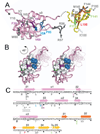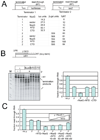Two structurally independent domains of E. coli NusG create regulatory plasticity via distinct interactions with RNA polymerase and regulators
- PMID: 19500594
- PMCID: PMC2763281
- DOI: 10.1016/j.jmb.2009.05.078
Two structurally independent domains of E. coli NusG create regulatory plasticity via distinct interactions with RNA polymerase and regulators
Abstract
NusG is a conserved regulatory protein that interacts with elongation complexes (ECs) of RNA polymerase, DNA, and RNA to modulate transcription in multiple and sometimes opposite ways. In Escherichia coli, NusG suppresses pausing and increases elongation rate, enhances termination by E. coli rho and phage HK022 Nun protein, and promotes antitermination by lambdaN and in ribosomal RNA operons. We report NMR studies that suggest that E. coli NusG consists of two largely independent N- and C-terminal structural domains, NTD and CTD, respectively. Based on tests of the functions of the NTD and CTD and variants of NusG in vivo and in vitro, we find that NTD alone is sufficient to suppress pausing and enhance transcript elongation in vitro. However, neither domain alone can enhance rho-dependent termination or support antitermination, indicating that interactions of both domains with ECs are required for these processes. We propose that the two domains of NusG mediate distinct interactions with ECs: the NTD interacts with RNA polymerase and the CTD interacts with rho and other regulators, providing NusG with different combinations of interactions to effect different regulatory outcomes.
Figures







Similar articles
-
Thermotoga maritima NusG: domain interaction mediates autoinhibition and thermostability.Nucleic Acids Res. 2017 Jan 9;45(1):446-460. doi: 10.1093/nar/gkw1111. Epub 2016 Nov 29. Nucleic Acids Res. 2017. PMID: 27899597 Free PMC article.
-
Structural Basis for Transcript Elongation Control by NusG Family Universal Regulators.Cell. 2018 Jun 14;173(7):1650-1662.e14. doi: 10.1016/j.cell.2018.05.017. Epub 2018 Jun 7. Cell. 2018. PMID: 29887376 Free PMC article.
-
Identification of a structural element that is essential for two functions of transcription factor NusG.Biochim Biophys Acta. 2005 Jun 30;1729(2):135-40. doi: 10.1016/j.bbaexp.2005.04.002. Epub 2005 Apr 25. Biochim Biophys Acta. 2005. PMID: 15890417
-
NusG-Spt5 Transcription Factors: Universal, Dynamic Modulators of Gene Expression.J Mol Biol. 2025 Jan 1;437(1):168814. doi: 10.1016/j.jmb.2024.168814. Epub 2024 Oct 5. J Mol Biol. 2025. PMID: 39374889 Free PMC article. Review.
-
The yin and yang of the universal transcription factor NusG.Curr Opin Microbiol. 2024 Oct;81:102540. doi: 10.1016/j.mib.2024.102540. Epub 2024 Sep 2. Curr Opin Microbiol. 2024. PMID: 39226817 Review.
Cited by
-
An autoinhibited state in the structure of Thermotoga maritima NusG.Structure. 2013 Mar 5;21(3):365-75. doi: 10.1016/j.str.2012.12.015. Epub 2013 Feb 14. Structure. 2013. PMID: 23415559 Free PMC article.
-
NusG-Spt5 proteins-Universal tools for transcription modification and communication.Chem Rev. 2013 Nov 13;113(11):8604-19. doi: 10.1021/cr400064k. Epub 2013 May 2. Chem Rev. 2013. PMID: 23638618 Free PMC article. Review. No abstract available.
-
Exploring RNA polymerase regulation by NMR spectroscopy.Sci Rep. 2015 Jun 4;5:10825. doi: 10.1038/srep10825. Sci Rep. 2015. PMID: 26043358 Free PMC article.
-
Characterization of backbone dynamics using solution NMR spectroscopy to discern the functional plasticity of structurally analogous proteins.STAR Protoc. 2021 Oct 29;2(4):100919. doi: 10.1016/j.xpro.2021.100919. eCollection 2021 Dec 17. STAR Protoc. 2021. PMID: 34761231 Free PMC article.
-
NusA directly interacts with antitermination factor Q from phage λ.Sci Rep. 2020 Apr 20;10(1):6607. doi: 10.1038/s41598-020-63523-5. Sci Rep. 2020. PMID: 32313022 Free PMC article.
References
-
- Burova E, Gottesman ME. NusG overexpression inhibits Rho-dependent termination in Escherichia coli. Mol Microbiol. 1995;17:633–641. - PubMed
-
- Pasman Z, von Hippel PH. Regulation of rho-dependent transcription termination by NusG is specific to the Escherichia coli elongation complex. Biochemistry. 2000;39:5573–5585. - PubMed
Publication types
MeSH terms
Substances
Associated data
- Actions
- Actions
Grants and funding
LinkOut - more resources
Full Text Sources
Molecular Biology Databases

